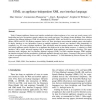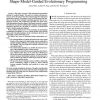7416 search results - page 1478 / 1484 » Design of an Anatomy Information System |
BMCBI
2002
13 years 7 months ago
2002
Background: Expressed sequence tags (ESTs) are single pass reads from randomly selected cDNA clones. They provide a highly cost-effective method to access and identify expressed g...
COMPUTER
1998
13 years 7 months ago
1998
ER ABSTRACTIONS ter service uses several abstractions— including resource, resource dependencies, and resource groups—to simplify both the cluster service itself and user-visib...
CN
1999
13 years 7 months ago
1999
Today's Internet appliances feature user interface technologies almost unknown a few years ago: touch screens, styli, handwriting and voice recognition, speech synthesis, tin...
SAC
2002
ACM
13 years 7 months ago
2002
ACM
We present a generic mobility and traffic generation framework that can be incorporated into a tool for modeling and simulating large scale ad hoc networks. Three components of thi...
TMI
2002
13 years 7 months ago
2002
This paper presents a fully automated segmentation method for medical images. The goal is to localize and parameterize a variety of types of structure in these images for subsequen...


